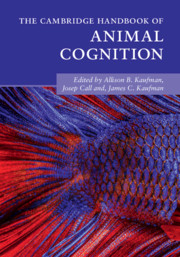Book contents
- The Cambridge Handbook of Animal Cognition
- The Cambridge Handbook of Animal Cognition
- Copyright page
- Dedication
- Contents
- Figures, Tables, and Boxes
- Contributors
- Acknowledgments
- Introduction
- Part I Communication and Language
- Part II Memory and Recall
- Part III Social Cognition
- Part IV Social Learning and Teaching
- Part V Numerical and Quantitative Abilities
- Part VI Innovation and Problem-Solving
- 28 Innovation and Problem-Solving Overview
- 29 General Intelligence (g) in Mice
- 30 Bowerbird Innovation and Problem-Solving
- 31 Parrot Innovation
- 32 Innovation in Marine Mammals
- 33 Innovation in Capuchin Monkeys
- 34 Innovation and Problem-Solving in Orangutans
- 35 Do Apes and Monkeys Know What They (Don’t) Know?
- 36 Decision Making in Animals
- Index
- References
36 - Decision Making in Animals
Rational Choices and Adaptive Strategies*
from Part VI - Innovation and Problem-Solving
Published online by Cambridge University Press: 01 July 2021
- The Cambridge Handbook of Animal Cognition
- The Cambridge Handbook of Animal Cognition
- Copyright page
- Dedication
- Contents
- Figures, Tables, and Boxes
- Contributors
- Acknowledgments
- Introduction
- Part I Communication and Language
- Part II Memory and Recall
- Part III Social Cognition
- Part IV Social Learning and Teaching
- Part V Numerical and Quantitative Abilities
- Part VI Innovation and Problem-Solving
- 28 Innovation and Problem-Solving Overview
- 29 General Intelligence (g) in Mice
- 30 Bowerbird Innovation and Problem-Solving
- 31 Parrot Innovation
- 32 Innovation in Marine Mammals
- 33 Innovation in Capuchin Monkeys
- 34 Innovation and Problem-Solving in Orangutans
- 35 Do Apes and Monkeys Know What They (Don’t) Know?
- 36 Decision Making in Animals
- Index
- References
Summary
Humans often appear to defy principles of economic "rationality" when making decisions, by falling prey to a suite of choice biases including over-weighting immediate gratification, avoiding risk, treating identical options differently depending on whether they are perceived as a relative loss or gain, or attaching more value to objects in their possession. Here we examine what animals can tell us about these choice patterns. First, we provide an overview of different theoretical frameworks for rational decision making from psychology, economics, and biology. Next, we review empirical work examining how different species make decisions and discuss how many potentially puzzling patterns of decision making may be biologically adaptive when considering the environment in which they are made. Finally, we propose that integrating various theoretical perspectives with comparative data can elucidate the ultimate origins of variations in decision-making strategies across species and provide a new framework to illuminate the adaptive value of these strategies.
- Type
- Chapter
- Information
- The Cambridge Handbook of Animal Cognition , pp. 770 - 791Publisher: Cambridge University PressPrint publication year: 2021

